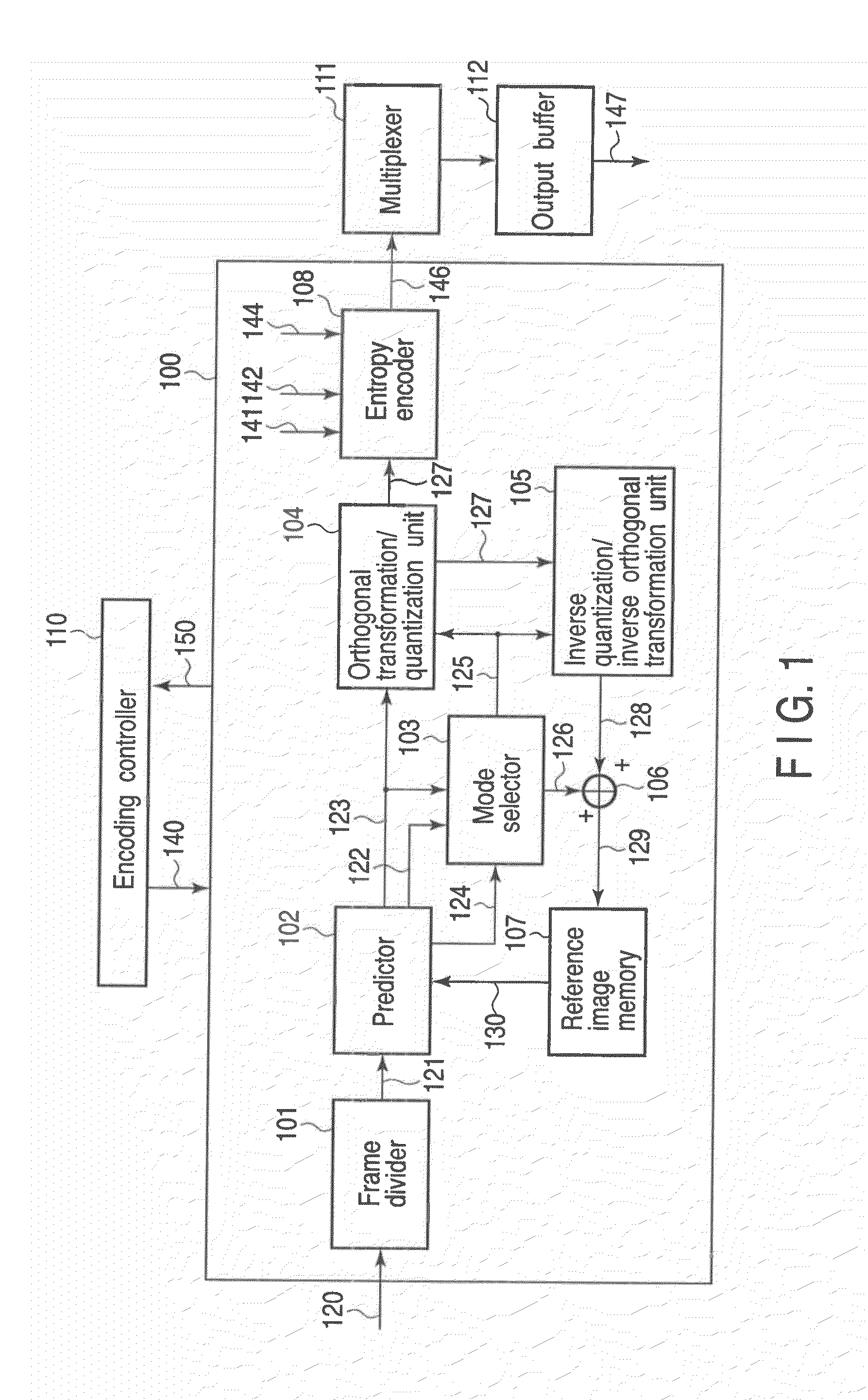Method and apparatus for encoding and decoding image
a technology of moving or still images and methods, applied in the field of methods and apparatus for encoding and decoding moving or still images, can solve the problems of encoding efficiency reduction, increasing prediction residual error, etc., and achieves the effect of improving prediction efficiency, and reducing prediction residual error
- Summary
- Abstract
- Description
- Claims
- Application Information
AI Technical Summary
Benefits of technology
Problems solved by technology
Method used
Image
Examples
first embodiment
f Syntax Structure
[0345]As another example, a plurality of reliability candidates of prediction modes in the bidirectional prediction may be prepared in units of blocks and switched in units of the blocks. A concrete syntax configuration is shown in FIG. 43. The configuration of the macro-block prediction syntax shown in FIG. 34 is replaced with the configuration shown in FIG. 43. Reference symbol intra4×4_bi_pred_weight_mode shown in FIG. 43 is data representing which reliability candidate is used for the 4×4 pixel blocks. For example, when the intra4×4_bi_pred_weight mode is 0, a Gaussian distribution is allocated. When the intra4×4_bi_pred_weight_mode is 1, a Laplace distribution is allocated. When the intra4×4_bi_pred_weight_mode is 2, a fixed value is allocated. As another distribution, a linear model or an M-order function (M≧1) can be replaced.
[0346]FIGS. 44, 45, 46, 47, and 48 show still another example of a syntax structure used in the image encoder 100. Pieces of syntax in...
second embodiment
Syntax Structure
[0450]FIGS. 70, 71, 72, 73, and 74 show still another examples of the structure of the syntax used in the image encoder 100. The syntax information required in the examples includes the sequence parameter set syntax 202, the picture parameter set syntax 203, the slice header syntax 205, and the macro-block layer syntax 208 in FIG. 32. The syntaxes shown in FIGS. 70, 71, 72, 73, and 74 are added to the syntax structure of the first example. The syntaxes will be described below.
[0451]Reference symbol block_order_in_seq_flag shown in the sequence parameter set syntax in FIG. 70 denotes a flag representing whether switching of prediction orders is made possible in a sequence. When the flag block_order_in_seq_flag is TRUE, the prediction orders can be switched in the sequence. On the other hand, when the flag block—order—in_seq_flag is FALSE, the prediction orders cannot be switched in the sequence. Reference symbol block_order_in_pic_flag in the picture parameter set syn...
third embodiment
f Syntax Structure
[0488]FIGS. 29, 30, 31, 32, 33, and 34 show other examples related to syntax structures related to the image decoding apparatus. Since the explanations of the syntaxes are the same as those in the image encoding apparatus, a description thereof will be omitted. The syntaxes are separated from bit streams and decoded to obtain information. Furthermore, the syntaxes may be switched depending on activity information such as correlation or variance of pixels in a decoded adjacent block. In this case, by using the same logic as that on the encoding side, the same information of the syntaxes as that in the encoding is shown. For this reason, separating and decoding processes from an encoding bit stream are not necessary.
[0489]According to one embodiment of the present invention, since the number of usable prediction modes can be selected, for example, bidirectional prediction which calculates prediction signals obtained in a plurality of prediction modes in units of pixe...
PUM
 Login to View More
Login to View More Abstract
Description
Claims
Application Information
 Login to View More
Login to View More - R&D
- Intellectual Property
- Life Sciences
- Materials
- Tech Scout
- Unparalleled Data Quality
- Higher Quality Content
- 60% Fewer Hallucinations
Browse by: Latest US Patents, China's latest patents, Technical Efficacy Thesaurus, Application Domain, Technology Topic, Popular Technical Reports.
© 2025 PatSnap. All rights reserved.Legal|Privacy policy|Modern Slavery Act Transparency Statement|Sitemap|About US| Contact US: help@patsnap.com



